A greenhouse made from straw bales? It’s certainly interesting but many would be doubtful about this idea.
Yes, it’s affordable (even money-saving for some), environment friendly and provides good insulation. But is it strong enough?
The good news is a straw bale greenhouse is just like any other construction project – it could either be a disaster or the best greenhouse you’ll ever have. It all depends on how you build it and how intense the weather conditions can be in your area!
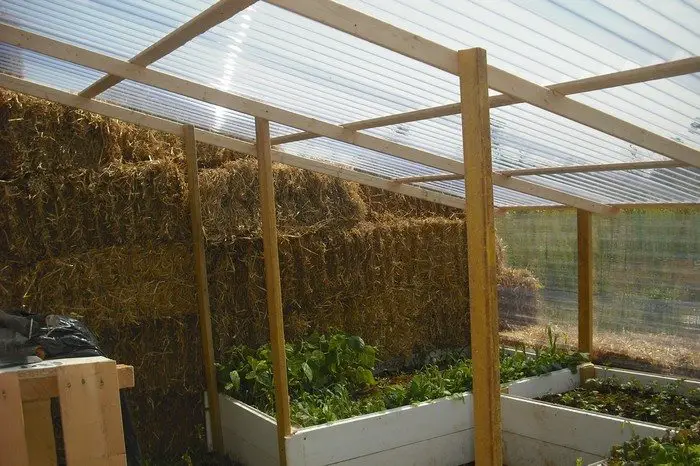
But there are large straw bale greenhouse constructions that prove this build is one great option you can consider. With enough research, proper design, and quality build, a straw bale greenhouse should work just as well as the more common greenhouses that people DIY.
The example that you see above is a nice start, BUT it’s an unfinished project.
Contents
Straw Bale Greenhouse Pointers
Make sure to protect the straw bales from the weather by plastering them. Leaving them exposed will cause them to eventually rot, which you obviously do not want. There are many sources for a plaster recipe out there. You can also find one that includes cement to make your straw bale walls more water-resistant.
Do not forget to include operable windows in your greenhouse design. Having them will allow you to release excess moisture that builds up. This will help protect the straw bale walls in the long term.
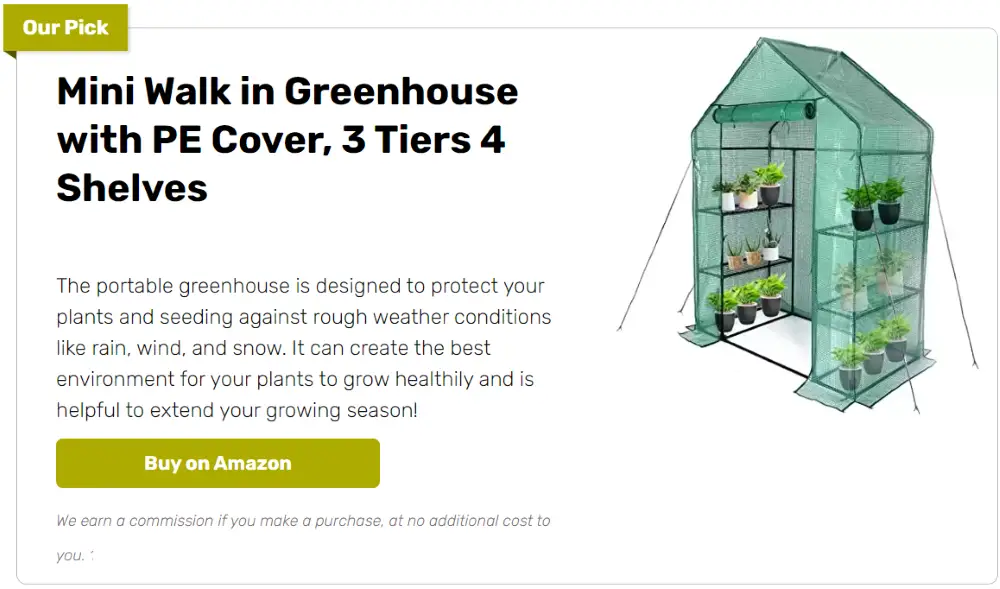
Last but not the least, use polycarbonate greenhouse sheets if possible – for your ceiling and non-straw bale walls. Polycarbonate sheets are a strong, double-wall, lightweight material that provides great light transmission but filters out harmful rays at the same time. It’s a perfect complement to your relatively light straw bale walls as well as great for your plants!
Now as mentioned earlier, building a good straw bale greenhouse will depend on many factors – space, location, budget, available materials, weather… If you do not have much building experience, make sure to ask professionals or more knowledgeable friends for help in design and construction. :)
Building a Straw Bale Greenhouse
Materials
- PVC
- Timber
- Clear Corrugated Roofing Panels
- Straw Bale
Tools
- Cordless Drill
- Measuring Tape
- Spirit Level
- Shovel
- Hammer
- Table Saw
Instructions
Step 1: Design and Planning
- Measure and Mark: Decide the size of your greenhouse and mark the ground where you plan to build it. Use a measuring tape and stakes to outline the area.
- Design Considerations: Plan the placement of doors and windows. Ensure the design allows for adequate light and ventilation.
Step 2: Foundation
- Dig the Foundation: Using a shovel, dig a trench for the foundation about 6 inches deep and 12 inches wide around the perimeter of the marked area.
- Lay the Foundation: Fill the trench with a layer of gravel for drainage, then lay PVC pipes horizontally to serve as a moisture barrier between the ground and the straw bales.
Step 3: Frame Construction
- Build the Frame: Use timber to construct a frame for the greenhouse. This includes vertical supports and roof trusses. A table saw will help cut timber to precise lengths.
- Secure the Frame: Assemble the frame using a cordless drill and screws. Use a spirit level to ensure all vertical supports are level.
Step 4: Installing Straw Bales
- Lay Straw Bales: Position straw bales around the perimeter of the frame on the PVC foundation. Ensure the bales are tight and compact to improve insulation.
- Trim Bales as Needed: Use a saw or sharp knife to trim any bales to fit the dimensions of your greenhouse structure.
Step 5: Roof Installation
- Attach Roofing Panels: Install clear corrugated roofing panels on top of the timber trusses. Secure them with screws using a cordless drill. Ensure the panels overlap to prevent water ingress.
- Seal the Edges: Seal the edges of the roofing panels with silicone sealant to enhance waterproofing.
Step 6: Plastering the Walls
- Prepare Plaster Mix: Mix a plaster suited for straw bale construction—typically a lime-based plaster that will adhere well to straw.
- Apply Plaster: Use a trowel to apply plaster over the straw bales. Cover all exposed straw to protect against weather and pests.
Step 7: Finishing Touches
- Install Doors and Windows: Fit doors and windows into the designated openings in the straw bale walls. Ensure they are well-sealed to maintain temperature and humidity control.
- Inspect and Patch: Inspect the structure for any gaps in the plaster or roofing and patch as necessary to ensure a tight seal.
Step 8: Interior Setup
- Install Shelving: Use remaining timber to create shelving inside the greenhouse for plants. This can be customized based on the type of plants you intend to grow.
- Setup Irrigation: If required, set up an irrigation system to simplify watering your plants.
Click on any image to start the lightbox display. Use your Esc key to close the lightbox.![]()
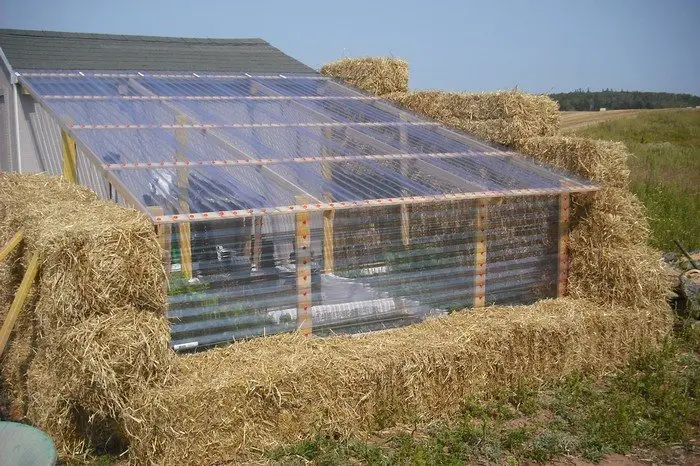

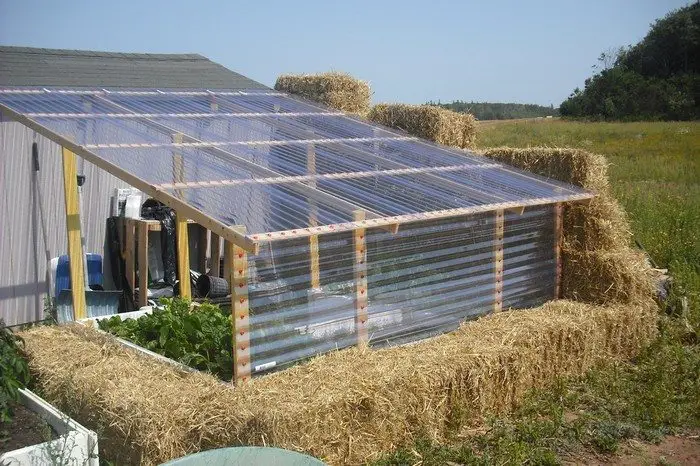
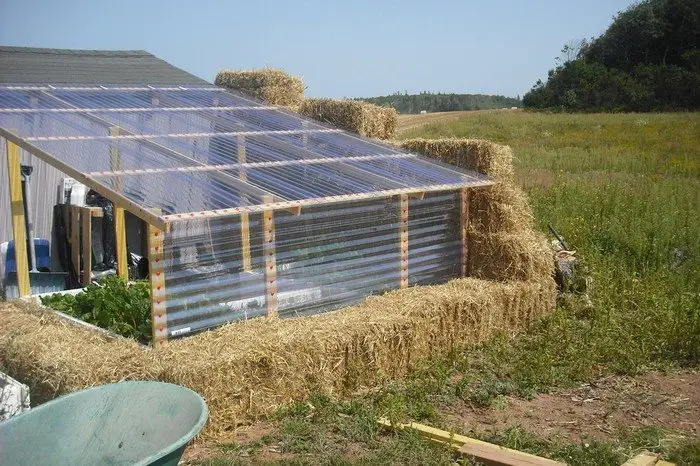

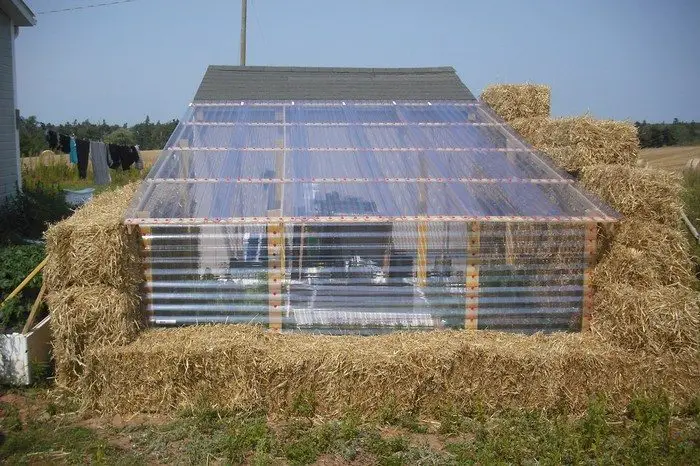
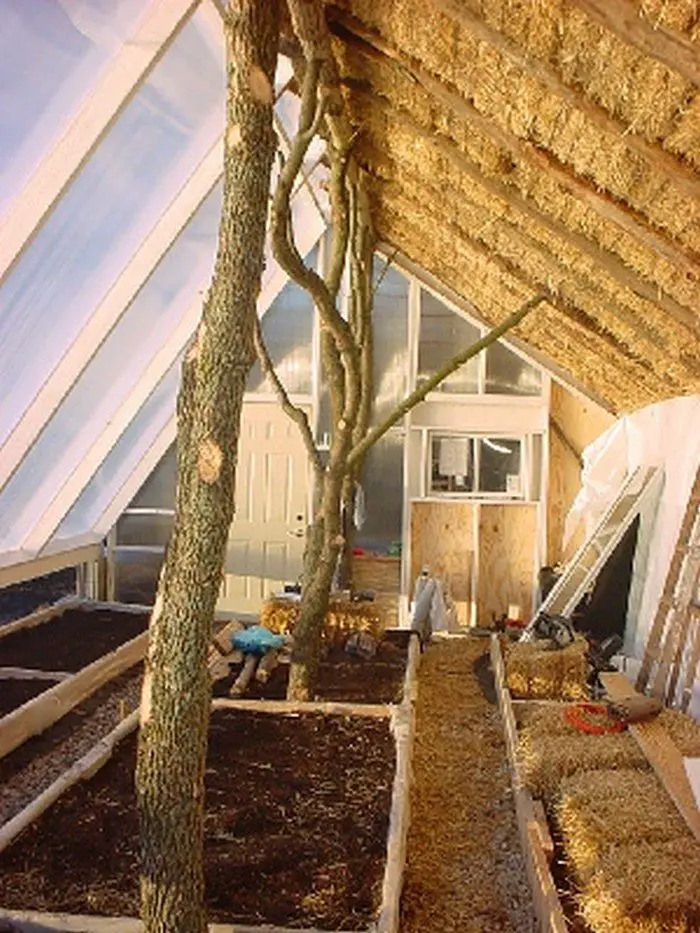
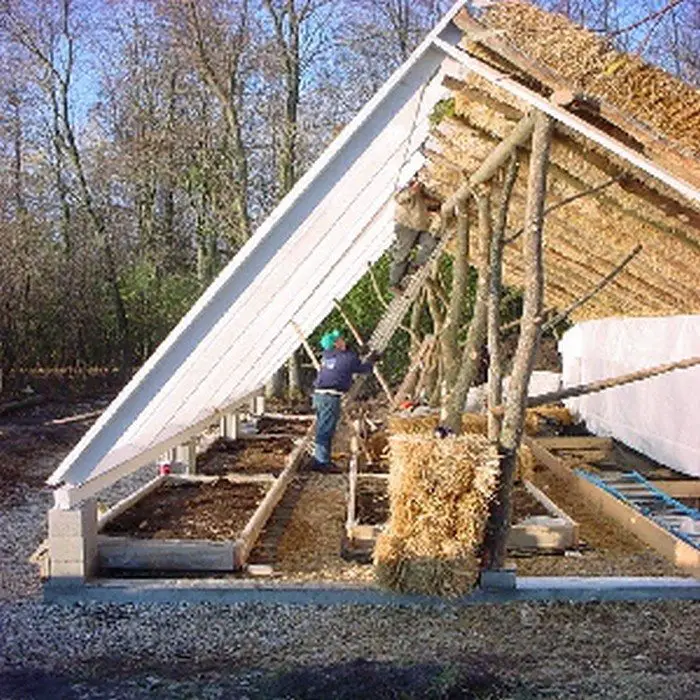

You can get more step-by-step instructions from Tracey Allen over at Simplify & Save…
Benefits of Straw Bale Construction in Greenhouses
Straw bale construction offers a unique and eco-friendly approach to building greenhouses. This method, which uses straw bales as primary building materials, has gained popularity due to its sustainability, cost-effectiveness, and energy efficiency. A straw bale greenhouse not only provides a robust environment for growing plants but also contributes to a greener planet by utilizing natural materials.
Below are the significant benefits of choosing straw bale construction for greenhouses.
Sustainable Building Material
Straw is a rapidly renewable resource that significantly reduces the environmental impact of construction. By using straw bales, you’re repurposing agricultural by-products that might otherwise be burned or wasted.
This reduces landfill use and provides a new purpose for what is essentially an agricultural leftover. A straw bale greenhouse integrates seamlessly into the natural cycle, turning what would be agricultural waste into valuable construction material.

Superior Insulation
One of the most notable advantages of a straw bale greenhouse is its incredible insulation properties. Straw bales have a high R-value, which means they provide substantial resistance to heat flow.
This excellent insulation keeps the interior of the greenhouse warm during the colder months and cool in the summer, creating a stable environment that is ideal for plant growth. The insulation also means that heating and cooling costs are significantly reduced, making a straw bale greenhouse a cost-effective choice for growers.
Cost-Effective Construction
Typically speaking, building a straw bale greenhouse is less costly than building a conventional glass or plastic greenhouse. Particularly if obtained locally, straw bales have rather low cost.
Further lowering the total cost are construction’s simplicity and the little demand for costly framing materials. A straw bale greenhouse offers reasonably priced year-round gardening for those on a budget.
Enhanced Durability
Though there are some misunderstandings, a well built straw bale greenhouse is quite robust. A natural plaster covers the bales to guard against pests and the elements. Proper maintenance of this plaster layer will help it to harden and create a strong, protective shell capable of many years of use.
Furthermore, the thickness and density of the straw bale walls provide the building natural strength that resists winds and heavy snow loads better than some traditional greenhouse materials.
Environmental Benefits
Choosing to build a straw bale greenhouse has a positive impact on the environment beyond just the use of natural materials. The energy efficiency of the structure reduces the amount of artificial heating and cooling required, which in turn lowers energy consumption and the carbon footprint. By fostering a more natural growing environment, this type of greenhouse also promotes healthier plant growth without the extensive use of chemical aids.
Aesthetic Appeal
A straw bale greenhouse does not only serve functional purposes but also adds an aesthetic value to any space. The natural look of the straw walls can blend beautifully with garden landscapes, creating a rustic, charming appearance that enhances the overall ambiance of the gardening area. This visual appeal can turn an ordinary garden into a picturesque and inviting space.
A straw bale greenhouse offers numerous benefits that make it an excellent choice for both novice and experienced gardeners. From its environmental friendliness and cost-efficiency to its superior insulation properties and aesthetic appeal, this type of greenhouse stands out as a sustainable and practical solution in modern gardening.
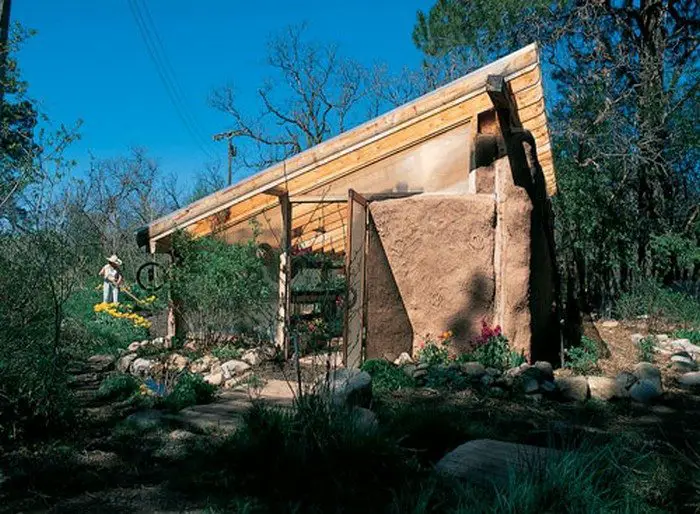
Weatherproofing Strategies
Weatherproofing is a critical aspect of building a straw bale greenhouse, ensuring it withstands various weather conditions and maintains a conducive environment for plant growth. Straw bale construction, while offering excellent insulation and environmental benefits, requires specific strategies to protect against moisture, wind, and other elements.
Here are effective weatherproofing techniques to enhance the durability and functionality of a straw bale greenhouse.
Moisture Control
- Elevated Foundation: Start by raising the foundation of your straw bale greenhouse to prevent moisture from wicking up from the ground. Use a waterproof barrier such as a PVC liner between the ground and the first layer of straw bales to further protect against moisture.
- Proper Plastering: Applying a suitable plaster is essential for protecting the straw bales from external moisture. A lime-based plaster not only adheres well but also allows the walls to ‘breathe,’ letting out internal moisture without letting in rain or snow. Ensure the plaster is well-applied and maintained to prevent cracks where water could enter.
- Adequate Roof Overhang: Design the roof with sufficient overhang to shield the walls from rain. The overhang should extend at least 18 inches beyond the walls to effectively divert water away from the base of your straw bale greenhouse.
Wind Resistance
- Reinforced Framing: Incorporate a sturdy timber frame within the structure of your straw bale greenhouse. This frame supports the straw bales and provides additional resistance against high winds.
- Strapping and Tying: Use strapping or mesh to tie the straw bales to the internal framework securely. This method ensures the bales remain intact and stable even during strong winds, safeguarding the structural integrity of the greenhouse.
- Aerodynamic Shape: Opt for a design that minimizes wind resistance. Rounded or sloped sides can help reduce the wind load on the straw bale greenhouse, preventing damage during gusty conditions.
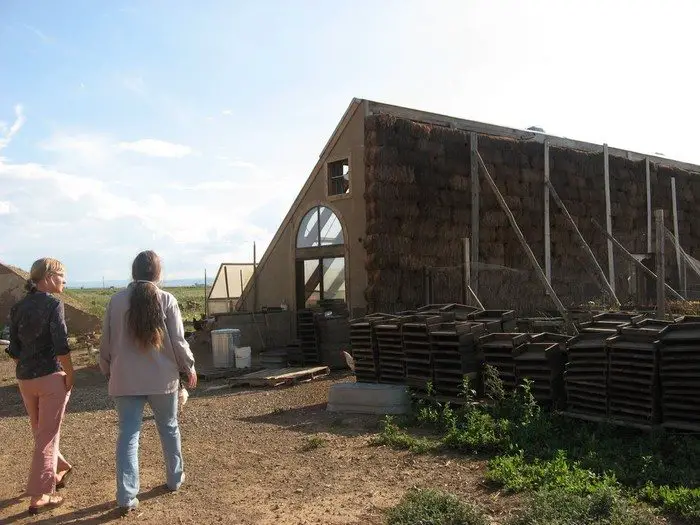
Temperature Regulation
- Reflective Coatings: Apply reflective coatings to the exterior of the greenhouse to reflect sunlight and reduce heat absorption. This strategy is particularly beneficial in hot climates where overheating could harm plant growth.
- Strategic Ventilation: Ensure your straw bale greenhouse has operable windows or vents at strategic locations to allow for adequate air circulation. This not only helps in controlling the internal temperature but also reduces the buildup of moisture that could compromise the straw bales.
- Insulating Layers: Consider adding extra insulating layers such as bubble wrap or shading cloth inside the greenhouse during extreme temperatures. These can be removed or adjusted as needed to maintain optimal growing conditions.
By implementing these weatherproofing strategies, your straw bale greenhouse will be better equipped to handle different weather challenges, providing a stable and sustainable environment for your plants. Regular maintenance and inspections will also play a crucial role in ensuring that the weatherproofing measures remain effective over time.
Conclusion
Straw bale greenhouses offer a sustainable and cost-effective solution for year-round gardening, utilizing natural materials to provide excellent insulation and reduce energy costs. Their robust construction and aesthetic appeal blend beautifully with natural landscapes, enhancing the overall gardening experience. With proper maintenance, these greenhouses prove to be durable and environmentally friendly, making them a wise choice for eco-conscious gardeners.





